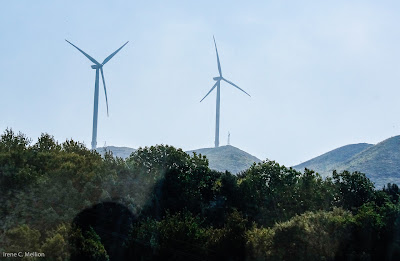Day 12 & 13, (April 13 & 14, 2013) of our OAT's Turkey's Sacred lands and Ancient Civilizations Tour. We explore Antioch, visit an Armenian village, scramble along an immense tunnel and dip our toes in the Mediterranean.
Antioch is an ancient city on the Orontes River in Turkey. Its ruins lie near the modern city of Antakya. It was founded near the end of the 4th century BC by one of Alexander the Great's generals, Seleucus I Nicator.
Antioch's geographic, military and economic location were good, the city prospered, and eventually it rivaled Alexandria as the chief city of the Near East. It's location was near the spice trade routes, the Silk Road, and the Persian Royal Road.
Antioch played a pivotal role in the emergence of both Judaism and early Christianity. It has been called "the cradle of Christianity.
St Peter's Church
Acts of the Apostles (11:25-27) relates the biblical story of the Apostle Paul and his travel to Antioch. Converts there were called Christians for the first time in history. Tradition considers Peter as the founder of the church of Antioch; it is one of the first Christian church
Because of restoration we were unable to even get near.
 |
| The church is behind the sloping structure, under restoration |
During the Middle Ages Antioch declined in significance partially due to repeated earthquakes, the Crusaders' invasions, and a change in trade routes.
Today Antakya (Antioch) prides itself on its diverse population, an unusually successful multi-culturalism (Arab-Sunni, Arab-Alevi, Arab-Orthodox, Turkmen and Turks) and its very rich history.
 |
| Old houses are in the older sections of town |
Wind turbines and microwave dishes
 |
| The green on the left is not grass, but another building! |
 |
| "skinny" mosque |
Walk to the Market
You can buy almost anything in the Bazaar
 |
| Our fearless guide explains what we are seeing |
 |
| This is green henna |
 |
| "Cay" is tea |
 |
Peppers,, eggplant and other dried vegetable sold by the string.
The shells are soaked in warm water and stuffed. |
 |
| The Sorcerer's Apprentice's worst nightmare! |
 |
| I was offered a "ride" on this mules's saddle |
 |
| ??? |
 |
| bird shop |
Pasta dough is pipetted onto a hot, flat surface and baked. The stiff pasta is combined with cheese and other ingredients in a pan and cooked over coal for a delicious dessert whose name I don't know.
 |
| My son, champion baker! |
 |
| Ready to be sold |
Vakifli-Only Armenian Village in Turkey
The next day we visited an Armenian village.
In 1939 when the Providence of Hatay joined the Republic of Turkey, five of the six Armenian villages then decided to relocate to Syria and Lebanon; only one village stayed--Vakifli.
We visited this charming, neat village and talked with a local representative. He explained that the villagers have a hard time finding spouses as they believed that one should not marry anyone more closely related than 7th cousin! Since the village is so small they are all related!
We also stepped into the church an listened to the church service being chanted in Armenian. It was an amazing experience.
 |
| Armenian tatting and crocheting |
 |
Oranges still on the tree from last year plus this year's blossoms
The fragrance was wonderful |
 |
| Neat Armenian house |
 |
| Mint, rose hip and apple tea for tea break |
Seleucia and the Titus Tunnel
Seleucus I Nicator of Syria founded Seleucia Pieria (present day Samandag) in 301 B.C. as the harbor for his capital in Antioch.
About 80 A.D. the Roman Emperor Titus commissioned a tunnel to divert flood waters from the mountains away from the harbor to prevent silting.
We went to visit this wonder of Roman engineering.
Getting there over the mountain of Moses
 |
| Moses Mountain |
 |
| This mountain is in Syria--I don't know it's name |
 |
| The present day harbor at Samandag. The ancient harbor was in a different location |
 |
The ravine (slash across the photo) leads to the Mediterranean.
The Titus tunnel is underground at the far right of the ravine and empties flood water into it. |
Exploring the Tunnel
We entered the tunnel along a walkway, then climbed down the rocks to the tunnel floor. The rocks were polished to a high shine and were very slippery.
The tunnel has two sections carved through the rock separated by a section of natural ravine walls
 |
| the start |
 |
| An irrigation canal runs along the tunnel (right) |
 |
| Tall walls! |
 |
| Looking into the second tunnel |
 |
| Looking up through the ravine |
 |
| Steps leading down from the ravine partially to the tunnel floor |
Fun at the beach
 |
| Nurdan operates the bus door and "accidentally" honks the horn |
 |
| People fleeing the honking bus! |
 |
| Beach dog |
After strolling the beach we headed back to our hotel.















































No comments:
Post a Comment